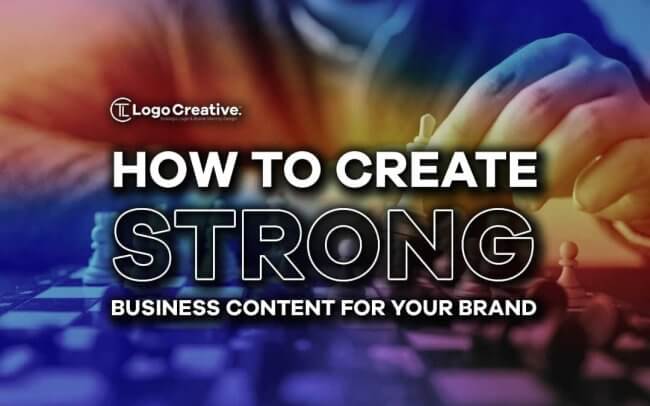There’s a lot that happens before putting fingers to the keyboard to create content that helps brand your business. Whether you are creating blogs, uploading images on Instagram, or developing website content, you must ensure the content promotes the unique feature of your business. In this article we look at How to Create Strong Business Content for Your Brand.
Creating strong business content is one of the surest ways to build trust in your brand, while informing and engaging your audience. It is a significant part of digital marketing that guilds loyalty and trust with customers.
Still, content writing for branding and marketing has become cluttered. Most content only receives a few eyeballs or interactions due to poor design. However, there is significant evidence to show that strong business content that inspires action and educates the reader works.
When you increase traffic to your business website, you also increase the number of user interactions which translates to more sales and increased brand loyalty. The business logo design is a critical aspect of content branding to optimize recognition and presence.
Read on to discover how you can create and promote business content that quickly delivers value to your brand.
Table of Contents
8 Steps to Creating Strong Business Content for Your Brand: A Beginner’s Guide
1. Define Your Brand and Business Goals
You will be surprised at the number of entrepreneurs who make the mistake of not branding their content. Branding covers items such as image standards, fonts, voice and tone, color palettes, and content type.
A brand guides business content foundation and lets the audience relate it to your business. Ensure you create a brand logo that represents the company’s personality and optimizes recognition. Branded content also has a higher ranking on search engines.
Additionally, strong business content must relate to the marketing goals and mission of the organization. The best way to set goals is to list the KPIs of the content strategy.
For instance, you can start by asking questions such as ‘what value should the business content add?’ If the answer is to inform or solve a problem, you will create content pieces that encourage user interactions and educate them.
2. Define Your Audience
You must figure out who you are trying to reach with your content and the most appropriate content for each channel. Buyer analysis ensures that the company doesn’t waste resources on the wrong audience.
Draw a template for each meaningful characteristic about your audience to guide your content focus. Some important features to consider when defining your audience include psychographics, demographics, pain points, personal/professional goals, impactful information sources, and purchase behaviors.
You can combine qualitative and quantitative information from different sources to gain insight, such as from social media reviews, competitors, and analysis by focus groups. Remember that your audience extends beyond your customer base and includes brand advocates and potential clients.
3. Create a Strategy for Content Development

A strategy is like a blueprint with all the details of the content framework. It involves defining the content themes, conducting keyword research, creating a content calendar, and identifying where to post your content. This step is critical in guiding strong business content creation because it keeps all parties on the same page.
You can use a visualization tool that shows the time allocated to each piece, the pending content pieces, and the effort required to produce them. Also, plan where you will place the company logo design. Usually, the logo is positioned at the top corner of the title page to inform users of your brand identity.
The stakeholders must understand their responsibilities for each task and have realistic deadlines to provide for unforeseen issues. As a bonus, this step ensures your content is diversified to cater to the needs of different audiences.
4. Brainstorm Ideas
Developing content ideas is one of the biggest challenges when you want to strengthen your brand through business content creation. However, this is a routine when creating strong business content.
The easiest way to generate good ideas is to brainstorm with cross-functional teams. Having people outside your team brings fresh and quality topic ideas from diverse viewpoints. You can also get valuable concepts to use in creating the best logo design for your brand.
Ideas can come from researching what your direct and indirect competitors are doing. You can also survey your audience by posing questions or conducting a search for ideas in popular media in your industry.
Additionally, find good topics and keywords to strengthen your content by searching popular google queries, studying top bloggers in your niche, working with influencers, and newsjacking.
While conducting topic ideation and keyword search, ensure you understand the audience’s intention. Select common formats and themes that connect with readers, such as how-to-guides, overviews, or pros and cons.
5. Start Creating
You can now go ahead to create content that caters to the preferences of the target audience. The three tips for making good branded content are maintaining authenticity, considering the audience, and telling a story.
Make sure you use descriptive headlines, leverage captivating graphics and color schemes, choose a good layout design, and add lists instead of long paragraphs. Strong branded content should consider best writing practices, such as grammar checks, proofreading, and keyword density analysis. You can also enlist business papers editing help to have your content reviewed and edited by professionals.
Use SEO tools to assess the readability of your content. Also, obey copyright laws by using free stock photos and citing your sources using links.
The content should stick to the agreed framework in terms of word count, text structure, and tone. Be ready to revise the work based on comments made by professional editors or stakeholders.
6. Optimize

Creating content that no one sees is pointless. The main goal of strong branded business content should be to deliver high-quality and relevant content to the reader after an online search query.
Optimize your content by including questions and long-tail keywords to boost ranking for search engines and audiences. Also, your content structure should be logical in terms of length, distribution of keywords, graphics, and headings.
To identify areas that require improvement, benchmark with top-ranking competitors and seek business papers editing help from professional writers. Your content needs to be helpful and easily accessible to your target audience. Include link the content back to the main site to help readers navigate easily to your service page.
7. Promote Your Content
Now that you have successfully created content that is useful, relevant, and elevates your brand, it’s time to blow your own trumpet and position the content to the right audience. Content promotion should align with the promotional channel, company goals, and brand.
The most effective and cheapest promotional tool is digital marketing. The strategy increases the visibility of your content using organic social media posts, email marketing, and social media influencers.
If you want to commercialize the content and grow your brand, the best approaches for creating leads are nurturing users and using gated content.
Nurturing users involves using advertising pixels to capture each person that clicks on your content into a marketing funnel. That way, you can set targeted advertisements that surface automatically on the audience’s social media feed related to what they read on your site.
Promotion using gated content requires the users to enter their details to access your content. That way, you gather useful information that will help you promote relevant content through email marketing.
It’s important to consider the platform you’re promoting on when designing a logo. For example, if you’re using traditional print, consider increasing contrast to account for the dull tones that are usually associated with print. Digital signs are a great way of promoting your logo’s colours and message as they can include animation and more information.
8. Tracking
The last step in creating strong business content for your brand is measuring and monitoring the content’s performance. Tracking is done for internal and external content to determine the most efficient channels. The metrics for measuring performance depend on the networks used to share business content.
Content shared on social media can be tracked using likes, shares, and comments. Likes show how much attention your content attracts on each platform, which can impact your brand.
The number of comments shows the level of user engagement with your brand, while shares act as free advertisements for your brand.
To track the performance of content shared on the business website, you can use metrics such as site traffic, bounce rate, on-site time, SEO metrics, and returning visitors.
The effectiveness of the logo can be measured using an online survey of users. The ultimate goal is to grow organic traffic to your website and create trust and loyalty to your brand. You also want to acquire quality backlinks that optimize your ranking.
In Conclusion
Feel free to use this guide to ensure that you create strong business content that evokes an emotional response to your brand and distinguishes you from competitors.
Your logo should be applied consistently in published content as a long-term branding strategy. Strong business content will drive traffic to your site and lead to business success because it resonates with the target audience.
Join The Logo Community
We hope this article about How to Create Strong Business Content for Your Brand has been helpful. If you would like more personal tips, advice, insights, and access to our community threads and other goodies, join me in our community. You can comment directly on posts and have a discussion.
*TIP – We use and recommend DesignCuts for all your fonts, mockups and design bundles.


